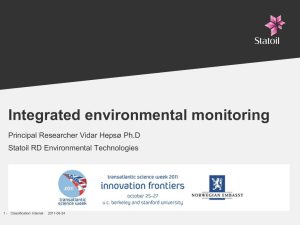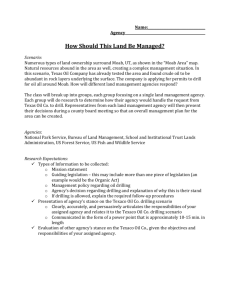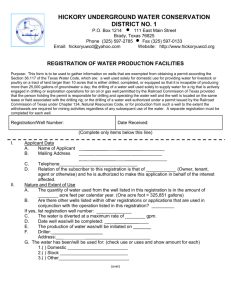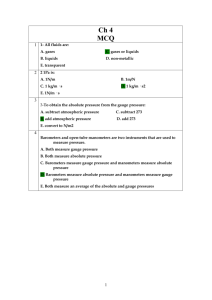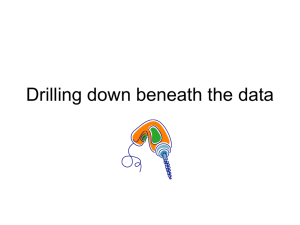Developing a High-Performance, Oil-Base Fluid for Exploration Drilling
advertisement
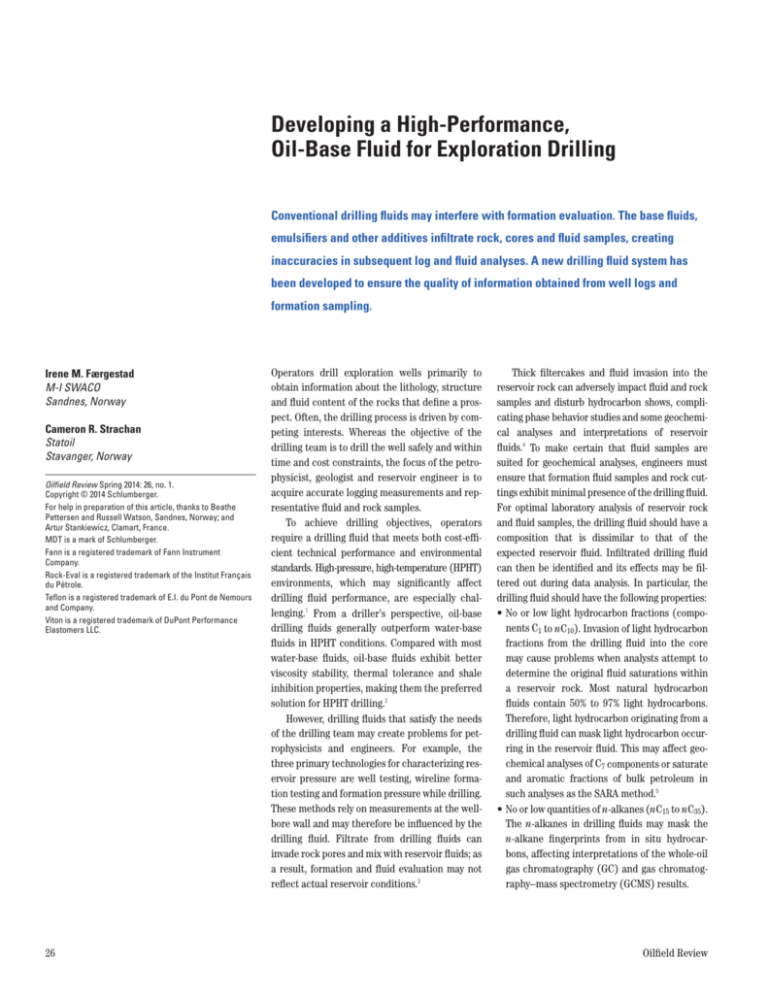
Developing a High-Performance, Oil-Base Fluid for Exploration Drilling Conventional drilling fluids may interfere with formation evaluation. The base fluids, emulsifiers and other additives infiltrate rock, cores and fluid samples, creating inaccuracies in subsequent log and fluid analyses. A new drilling fluid system has been developed to ensure the quality of information obtained from well logs and formation sampling. Irene M. Færgestad M-I SWACO Sandnes, Norway Cameron R. Strachan Statoil Stavanger, Norway Oilfield Review Spring 2014: 26, no. 1. Copyright © 2014 Schlumberger. For help in preparation of this article, thanks to Beathe Pettersen and Russell Watson, Sandnes, Norway; and Artur Stankiewicz, Clamart, France. MDT is a mark of Schlumberger. Fann is a registered trademark of Fann Instrument Company. Rock-Eval is a registered trademark of the Institut Français du Pétrole. Teflon is a registered trademark of E.I. du Pont de Nemours and Company. Viton is a registered trademark of DuPont Performance Elastomers LLC. 26 Operators drill exploration wells primarily to obtain information about the lithology, structure and fluid content of the rocks that define a prospect. Often, the drilling process is driven by competing interests. Whereas the objective of the drilling team is to drill the well safely and within time and cost constraints, the focus of the petrophysicist, geologist and reservoir engineer is to acquire accurate logging measurements and representative fluid and rock samples. To achieve drilling objectives, operators require a drilling fluid that meets both cost-efficient technical performance and environmental standards. High-pressure, high-temperature (HPHT) environments, which may significantly affect drilling fluid performance, are especially challenging.1 From a driller’s perspective, oil-base drilling fluids generally outperform water-base fluids in HPHT conditions. Compared with most water-base fluids, oil-base fluids exhibit better viscosity stability, thermal tolerance and shale inhibition properties, making them the preferred solution for HPHT drilling.2 However, drilling fluids that satisfy the needs of the drilling team may create problems for petrophysicists and engineers. For example, the three primary technologies for characterizing reservoir pressure are well testing, wireline formation testing and formation pressure while drilling. These methods rely on measurements at the wellbore wall and may therefore be influenced by the drilling fluid. Filtrate from drilling fluids can invade rock pores and mix with reservoir fluids; as a result, formation and fluid evaluation may not reflect actual reservoir conditions.3 Thick filtercakes and fluid invasion into the reservoir rock can adversely impact fluid and rock samples and disturb hydrocarbon shows, complicating phase behavior studies and some geochemical analyses and interpretations of reservoir fluids.4 To make certain that fluid samples are suited for geochemical analyses, engineers must ensure that formation fluid samples and rock cuttings exhibit minimal presence of the drilling fluid. For optimal laboratory analysis of reservoir rock and fluid samples, the drilling fluid should have a composition that is dissimilar to that of the expected reservoir fluid. Infiltrated drilling fluid can then be identified and its effects may be filtered out during data analysis. In particular, the drilling fluid should have the following properties: • No or low light hydrocarbon fractions (components C1 to nC10). Invasion of light hydrocarbon fractions from the drilling fluid into the core may cause problems when analysts attempt to determine the original fluid saturations within a reservoir rock. Most natural hydrocarbon fluids contain 50% to 97% light hydrocarbons. Therefore, light hydrocarbon originating from a drilling fluid can mask light hydrocarbon occurring in the reservoir fluid. This may affect geochemical analyses of C7 components or saturate and aromatic fractions of bulk petroleum in such analyses as the SARA method.5 • No or low quantities of n-alkanes (nC15 to nC35). The n-alkanes in drilling fluids may mask the n-alkane fingerprints from in situ hydrocarbons, affecting interpretations of the whole-oil gas chromatography (GC) and gas chromatography–mass spectrometry (GCMS) results. Oilfield Review • No or low concentration of biomarkers (terpanes and stearanes). Biomarkers are molecular remnants of biochemicals from organisms and can be measured in both oil and source rock. Biomarkers have unique fingerprints that provide information about the age, lithology, organic content, depositional environment and thermal maturity of the source rock and degree of oil degradation. Accurate biomarker analysis can provide important information on microbial degradation and on maturity of rocks and oil. A high biomarker concentration in the drilling fluid may negatively affect analysis of any fluids—especially condensates, which traditionally have low biomarker concentrations— by masking readings from the GCMS. • No or low concentrations of aromatic hydrocarbons, which are commonly used for assessing molecular maturity values. High concentrations of aromatic hydrocarbon in the drilling fluid can affect maturity assessments of the reservoir and strongly influence geochemical fingerprinting when taken using GC.6 To enable efficient and successful drilling, most conventional drilling fluids are formulated to have a stable viscosity, low fluid loss, low equivalent circulating density (ECD) and minimal barite settling, or sag. Stable viscosity provides optimal cuttings transport and minimal effects on pump pressure. Keeping fluid loss low prevents formation damage and reduction in wellbore productivity. Low ECD helps maintain bottomhole pressures to avoid the fracturing or collapse of wellbore walls. Barite, a common drilling fluid weighting agent, may cause a phenomenon known as barite sag. Barite sag occurs when the heavy barite particles settle to the low side of the hole or the bottom of the well; this phenomenon is most severe in high-angle wells, especially those exceeding 45° deviation. Barite sag may cause density variations in the wellbore fluid column, potentially creating well control issues. This article describes the development of a new drilling fluid designed to meet the require1. HPHT conditions defined by Norsk Sokkels Konkurranseposisjon (NORSOK) standard D-010 are wells with temperatures greater than 150°C [300°F] and bottomhole pressures greater than 69 MPa [10,000 psi]. Other organizations may define HPHT differently. 2. In some cases, formate fluids, which are water based, can perform as well as oil-base fluids. 3. Bennett B and Larter SR: “Polar Non-Hydrocarbon Contaminants in Reservoir Core Extracts,” Geochemical Transactions 1 (August 22, 2000), http://www. geochemicaltransactions.com/content/1/1/34 (accessed April 23, 2014). 4. Filtercake, also known as mudcake, is the residue deposited on a borehole wall at a permeable zone when drilling fluid is forced against it under pressure. Filtrate is Spring 2014 Fluid Specifications Set by Statoil Property Fann 35 dial reading at 600 rpm Fann 35 dial reading at 100 rpm Fann 35 dial reading at 3 rpm HPHT fluid loss on 10-micron disk Sag stability after 3 days Sag stability after 5 days Operator Specifications for New HPHT Fluid Average Values for Previously Used Fluid 103 lbf/100 ft2 As low as possible 2 Less than 24 lbf/100 ft 2 33 lbf/100 ft2 12 lbf/100 ft2 5 to 10 lbf/ft 3 Less than 3 mL [0.2 in. ] 160 kg/m3 [1.3 lbm/galUS] 3 300 kg/m3 [2.5 lbm/galUS] Less than 150 kg/m [1.2 lbm/galUS] Less than 150 kg/m 10 to 12 mL [0.6 to 0.7 in.3] 3 > HPHT fluid specifications. The specifications for fluid properties set by Statoil were based on the need for an improvement in performance compared with that of the drilling fluid previously in use in similar fields offshore Norway. To conduct the HPHT test, engineers used a 10-micron disk, which best represented the filtration capabilities of the formation rock to be drilled. To qualify for use, the new HPHT fluid needed to meet all specifications. Dial readings from a Fann 35 viscometer were taken at a fluid temperature of 50ºC [122ºF], and 30-minute HPHT fluid-loss tests were performed at a fluid temperature of 150ºC [300°F]. ments for drilling, well logging and sampling. Results from a field test offshore Norway demonstrate the minimal impact the new drilling fluid has on formation rocks and fluid and, in turn, on the majority of geochemical analyses.7 Development Criteria In 2010, Statoil sought a new HPHT drilling fluid that would not interfere with formation and fluid evaluation and that would ensure good pressure data for the Crux prospect, offshore Norway. Fluid experts at Statoil had two objectives. The first was to use an oil-base fluid that enables efficient and safe drilling operations while causing minimal impact on geochemical analyses of formation fluid samples. The second was to qualify for use a more reliable, low-ECD reservoir drill-in fluid (RDF) with properties that would be stable in HPHT environments without additional cost.8 All qualification tests and analyses of drilling fluid properties, formation damage and permeability were performed at the research laboratories of M-I SWACO, a Schlumberger company, in Sandnes, Norway. A set of first-use criteria was established by Statoil in collaboration with M-I SWACO.9 Of particular importance was the capacity to 5. 6. 7. 8. the liquid that passes from the drilling fluid into the formation, leaving the filtercake behind. SARA stands for saturates, aromatics, resins and asphaltenes and is a method that characterizes heavy oils in the four solubility classes based on their molecular weight species. Bennett and Larter, reference 3. Watson R, Johannesen J, Strachan C and Færgestad I: “Development and Field Trial of a New Exploration HPHT Reservoir Drill-In Fluid,” paper SPE 165099, presented at the SPE European Formation Damage Conference and Exhibition, Noordwijk, The Netherlands, June 5–7, 2013. A reservoir drill-in fluid is designed exclusively for drilling the reservoir section of a well. Qualification of fluids is a Statoil internal procedure. obtain high-purity formation fluid samples. Additionally, the drilling fluid needed to be stable, have fluid properties that did not deviate more than 10% from specifications and have the lowest possible potential for analysis disturbance.10 No existing M-I SWACO drilling fluid satisfied the strict Statoil requirements. M-I SWACO research engineers began development of a high-performance HPHT exploration drilling fluid by focusing on the specifications provided by Statoil (above). Statoil drilling fluid experts assessed the new fluid using a modified qualification process that included laboratory testing and optimizing to their specifications. Measurements and Analyses To measure critical characteristics, such as filtration volumes and permeability before and after contact with the drilling fluid, M-I SWACO engineers performed return permeability tests on core samples.11 Because of a limited availability of representative reservoir core samples, initial tests were performed on analogous outcrop core material that was selected based on the type of formation expected to be encountered in the exploration wells. Engineers used Berea sandstone 9. First-use criteria were set to evaluate the performance of the new fluid. 10. Disturbance factors may be C15+ hydrocarbon fractions, making data analysis more difficult by masking the hydrocarbon content of formation fluid or rock samples. 11. Return permeability tests compare initial permeability to that of the core sample after its exposure to drilling fluid under simulated downhole conditions. Return permeability is the ratio of a sample’s permeability after exposure to drilling fluid to its initial permeability, expressed as a percentage. 27 4.5 cm [1.77 in.] 3.84 cm [1.5 in.] > Filtrate invasion. After they finish a return permeability test on cores, engineers can often see filtrate invasion if it has occurred. After 20 hours of an application of oil-base mud, this core exhibits filtrate invasion to a shallow depth. Even though the filtrate invasion is fairly shallow (bottom, left of the yellow dashed line), the 32% return permeability indicates that damage to the core is significant. with permeabilities of 50 to 100 mD and Ohio sandstone with permeabilities of 1 to 10 mD (above). Final tests were performed using reservoir core material acquired from nearby production wells.12 Research engineers cleaned the sandstone core plugs with solvent, trimmed and tested them to determine base parameters such as grain density, porosity and permeability and then vacuum > Mounted core holder. The core holder is typically mounted vertically in the test equipment oven for return permeability measurements, with the formation side of the core upward and wellbore side downward. Production simulations are performed by flowing in the formation-to-wellbore direction (top to bottom). Test fluids are applied to the wellbore end of the core plug. 28 saturated the cores with synthetic brine that was formulated to match the fluid chemistry of the Crux prospect. To obtain a consistent and representative saturation relatively quickly, engineers used an ultracentrifuge to remove as much water as possible, leaving the core plugs at irreducible water saturation (next page, top right).13 The cores were then mounted in a hydrostatic core holder. To conduct the return permeability tests, engineers use a vertical core holder in which the core is placed with the formation end of the core at the top (next page, bottom right). A spacer ring at the bottom, or wellbore end, of the core creates an annulus with room for filtercake to build up during the pressure overbalance, or drilling, period of the test. Tubing carries fluid in and out of the annulus, allowing flow of drilling fluid that might contain small pieces of back-produced filtercake.14 Permeability is measured both with and without the filtercake in place. Engineers measure permeability at each stage of the tests. After mounting the core holder in the oven, they create conditions similar to the downhole environment by applying confining pressure and then increasing the temperature (left). When the core reaches a stable pressure and temperature, they measure permeability in the core with mineral oil flowing from the top to the bottom—from the formation into the wellbore. This permeability is designated ko1. Drilling fluid is then pumped at overbalance pressure in the opposite direction—wellbore to formation. A high-precision fluid pump system applies constant pressure while engineers record the filtrate loss into the core. After 20 hours, the overbalance is reduced, and engineers begin simulated production in the core by allowing flow, or back production, from the formation end into the wellbore end of the core. At a stable back-production rate, the engineers measure the permeability in the production direction (ko2) at four low flow rates.15 These four low flow rate measurements provide a statistically reliable permeability value. Engineers use these permeability data to determine return permeability: the ratio of ko2 to ko1, expressed as a percentage. High return permeability indicates low impact of the drilling fluid on the formation. After these permeability measurements are completed, the core is cooled and depressurized. Engineers remove the core from the core holder and photograph and characterize it. They remove any filtercake residues prior to remounting the core into the holder. They then measure the permeability in the formation-to-wellbore direction Oilfield Review in the absence of filtercake to obtain ko3. Finally, the core is prepared for post-test analysis to determine the reason for any changes in permeability observed throughout the experiment. Drilling fluid and its components, such as emulsifiers, clays and fluid-loss agents, can invade the rock, clog pores, mix with the native reservoir fluids and compromise geochemical analyses of cores and produced fluids.16 To map the possible disrupting effects of the drilling fluids planned for use in a well, engineers perform predrilling analyses: • Total organic carbon (TOC) analysis and Rock-Eval pyrolysis for characterization of sedimentary organic matter. TOC is a measure of the organic richness of a rock, which gives a semiquantitative measure of hydrocarbon potential. TOC is reported as weight % organic carbon. Rock-Eval pyrolysis assesses the quantity, quality, type and thermal maturity of whole rock and kerogen samples. • Deasphalting and group type separation. These techniques are used to extract specific components such as asphaltenes and other compounds from petroleum products; SARA analysis separates group types based on differences in solubility and polarity and is often performed as an open column, low-pressure liquid chromatographic separation. • Gas chromatography of whole oils. This method fingerprints individual oil samples, thus enabling scientists to determine essential oil composition. Whole-oil chromatograms display a collection of peaks of various size, all representing components of crude oil that are affected by factors such as depositional environment and lithology of the source rock, age of the oil and processes within the reservoir. The components making up the oil have differing size, chemical composition and properties; hence, they will 12. The described test methodology is specific to this case. 13. Byrne MT, Spark ISC, Patey ITM and Twynam AJ: “A Laboratory Drilling Mud Overbalance Formation Damage Study Utilising Cryogenic SEM Techniques,” paper SPE 58738, presented at the SPE International Symposium on Formation Damage Control, Lafayette, Louisiana, USA, February 23–24, 2000. 14. The filtercake may break into pieces when drawdown pressure is applied during back production. The tubes need an inner diameter that is large enough to allow these filtercake pieces to pass through along with the drilling fluid. 15. A constant differential pressure is applied to the core, and flow rate through the core is controlled by the permeability of the core plug. As the core plug permeability increases during drawdown, the flow rate increases until it reaches a plateau. The permeability is then measured. 16. Bennett and Larter, reference 3. Spring 2014 > Core preparation. Engineers use a centrifuge to determine capillary pressure curves and to prepare samples for return permeability tests. A disassembled centrifuge core holder and a centrifuge rotor (right ) stand ready for the next test. This centrifuge can accommodate three 3.84-cm [1.51-in.] cores simultaneously. Core holder cap, formation end Core holder body Formation end Flow direction Core Viton sleeve Wellbore end > Core holder setup. The core holder (right ) has been disassembled to show its components. The core is wrapped in Teflon coating (left, white), and a Viton sleeve (black) is placed over the core to protect the sides of the core from external interference. The fluid flow is directed in and out via the end faces of the core, from top to bottom; thus, no fluid should enter or exit the core from the core sides. Spacer ring Core holder cap, wellbore end 29 Oseberg East Crimp field Crux well Brage Oseberg SWEDEN Oseberg field Tune NORWAY Bergen Oslo Stavanger Oseberg South DENMARK > Fann 35 viscometer. The Fann Model 35 is a direct indicating, coaxial cylinder rotational viscometer. The outer cylinder rotates at known velocities. The test fluid is held in the gap between the cylinders. As the outer cylinder rotates, the fluid viscosity creates torque on the inner cylinder, known as the bob. The torque registers as deflections of a precision spring. Engineers read the spring deflections from the display at the top of the viscometer; readings are typically made at 600, 300, 100, 6 and 3 rpm. exit the column with specific time differences, creating peaks on the chromatogram. The height of and areas under the peaks correlate with concentration; therefore, their concentration ratios can be used to describe unique characteristics—fingerprints—of reservoirs and fields. In addition, the peaks allow analysts to identify various compounds in the sample. • GC with a flame ionization detector to determine the saturated hydrocarbon concentration of extractable petroleum hydrocarbons. The concentrations are determined by integrating the area under the peaks on the chromatogram. • GC with a mass spectrometer to identify biomarkers, diamondoids and aromatic hydrocarbons.17 Accurate biomarker analysis provides important information on microbial degradation and maturity of rocks and oil. Diamondoids in petroleum and sediment extracts have high thermal stability and resist oil cracking. Furthermore, diamondoids are generally more stable than all other hydrocarbon classes in geologic samples, which makes them more resistant to alteration processes such as biodegradation and maturation. Because of these 30 >Crimp field. The Statoil Crux exploration well lies in the new Crimp play in the North Sea west of Bergen, Norway. Crimp is an HPHT gas and condensate field that requires mud weights up to 1,900 kg/m3 [15.9 lbm/galUS] and has reservoir temperatures up to 155°C [311°F]. Development work has focused on formulating an HPHT drilling fluid designed for reservoir temperatures of 150°C with a mud weight of 1,750 kg/m3 [14.6 lbm/galUS]. (Photograph by Harald Pettersen, copyright Statoil. Used with permission.) properties, diamondoids have been used in evaluating geochemistry of source rocks and crude oils and in assessing biodegradation and thermal maturity of high-maturity crude oil and condensates. Aromatic hydrocarbons tend to resist moderate to heavy biodegradation; therefore, they offer an excellent way of differentiating biodegraded and unbiodegraded oils.18 Special laboratory tests, such as rheology measurements, HPHT fluid-loss tests and barite settling tests, are designed to evaluate drilling fluid viscosity, stability over time and filtration properties, which are important factors in determining the overall performance of a drilling fluid system. Using a Fann 35 viscometer, engineers measured the rheological properties of the new drilling fluid after mixing at 50°C [122°F], followed by hot rolling in an oven at 150°C [300°F]—the expected bottomhole temperature—to create the effect of dynamic aging (above left).19 After hot rolling, the engineers remeasured the viscosity at 50°C and performed HPHT filtration, also called fluid loss, of the hotrolled fluid. The HPHT filtration specifications consisted of a test temperature of 150°C and collecting filtrate through a 10-micron ceramic disk for 30 minutes. The barite settling test, known as a sag test, is performed by transferring 350 mL [21 in.3] of fluid to a 400-mL [24-in.3] steel cell to static age samples at 150ºC for 16 hours, 3 days and 5 days.20 For this test, technicians first separate the staticaged 350-mL drilling fluid sample in the aging cell into six layers, making certain to not disturb the fluid and to keep the cell vertical at all times.21 They then transfer the six layers to individual containers. The first layer consists of any separated, clear fluid on top of the drilling fluid; layers two to six, all of the same volume, contain drilling fluid of increasing mud weight. They then record the volume of separated fluid and weigh the other layers to find the mud weight. To calculate the barite sag, or the change in mud weight with depth in the cell, the initial mud weight is subtracted from the mud weight of the bottom layer. Connecting the Dots In addition to the qualification work done by M-I SWACO staff, Statoil engineers performed predrilling and company specific qualifying tests and analyses at their laboratory in Sandnes. Continual communication and results sharing throughout the development of the new fluid system ensured that the testing progressed as planned. The results showed that the final formulated drilling fluid passed all criteria set by Statoil for a fluid for use in an exploration well at the Crux prospect under the Oseberg field west of Bergen, Norway (above right). Results from the formation damage tests yielded calculated return permeability varying Oilfield Review Return Permeability Values for Four Tests Fluid Density, kg/m3 [lbm/galUS] Sandstone Core Material Test Temperature, °C [°F] Fluid Loss, mL [in.3] ko1, mD ko2, mD Calculated Return Permeability, % ko2/ko1 × 100 ko3, mD Calculated Return Permeability, % ko3/ko1 × 100 1,850 [15.4] Berea 135 [275] 7.5 [0.46] 69.50 56.50 81 56.70 82 1,850 [15.4] Crude oil–aged Berea 135 [275] 7.1 [0.43] 55.50 50.70 91 50.60 91 1,750 [14.6] Ohio 150 [300] 6.9 [0.42] 1.55 1.21 78 1.21 78 2,020 [16.9] Ohio 188 [370] 8.2 [0.50] 2.07 1.37 66 1.37 66 > Return permeability tests. Scientists performed two return permeability tests on high-permeability Berea sandstone cores and two on low-permeability Ohio sandstone cores. Return permeability was measured both with and without the filtercake in place. The new HPHT drilling fluid (green) was tested on an Ohio core at 150°C, yielding a return permeability of 78%, both with and without the filtercake. The initial permeability is designated ko1; permeabilities after back production with intact filtercake and without filtercake are designated ko 2 and ko 3, respectively. from 66% to 91% (above).22 The new drilling fluid used in the exploration well gave results of 78% return permeability, which Statoil considered a good result. Filtrate volumes recorded during the return permeability testing were acceptable. Filtercakes were thin in all experiments and did not stick to the wellbore face of the core plugs when engineers removed them from the core holder after tests (below).23 Permeability measurements changed little with or without filtercake, indicating that the filtercake had undergone “lift off” or “pop off” during back production. These terms describe how the filtercake separates from the formation surface at a given differential pressure; the pressure causes the filtercake to burst or break and come off in pieces or sheets. That the filtercake comes off easily indicates good drilling fluid performance and allows a logging tool rapid access to the pressurized formation fluids.24 Backscatter scanning electron microscopy of the wellbore end of the Berea core plug showed that directly behind the filtercake, pores of the rock were open and no drilling fluid components were present, demonstrating that the filtercake served to protect the porous formation from the drilling fluid (right). 0.5 cm [0.2 in.] 3.2 cm [1.3 in.] > Filtercake from a return permeability test. The filtercake produced by the new HPHT drilling fluid after the return permeability test is 0.5 cm thick and has a 3.2-cm diameter. The surface adjacent to the core plug is on the top, and the filtercake is intact, confirming that no filtercake has come off during simulated production. Spring 2014 0 μm 100 μm 200 μm 300 μm > Filtercake protection. A backscatter scanning electron micrograph of the wellbore end of an outcrop core taken after return permeability testing with the new HPHT drilling fluid shows drilling fluid solids (white) only on the wellbore face of the plug. The image shows no traces of deep fluid invasion into the core. The dense drilling fluid filtercake remnants appear as the bright area at the top of the image. 17. The mass spectrometer is placed downstream from the gas chromatograph. After molecules elute from the gas chromatograph at specific retention times, the mass spectrometer captures, ionizes, accelerates, deflects and detects the ionized molecules one by one. The molecules have been broken down into ionized fragments, and the mass spectrometer detects these fragments by identifying their mass-to-charge ratio. The preparative and analytical methods used are based on guidelines from the Norwegian Industry Guide to Organic Geochemical Analysis. For more: NIGOGA Edition 4.0 (May 30, 2000), http://www.npd.no/engelsk/ nigoga/default.htm (accessed February 14, 2014). 18. Wenger LM, Davis CL and Isaksen GH: “Multiple Controls on Petroleum Biodegradation and Impact on Oil Quality,” SPE Reservoir Evaluation & Engineering 5, no. 5 (October 2002): 375–383. 19. Hot rolling, also known as dynamic aging, is a procedure in which the 350-mL [21-in.3] fluid sample is transferred to a 400-mL [24-in.3] steel cell and put in an oven equipped with rollers. The cells roll in the oven for a specific amount of time at a specific temperature. Hot rolling simulates the wear of the drilling fluid under downhole conditions. Normal aging time is 16 hours. 20. Barite settling, or sag, testing is performed on static aged samples. In static aging, the samples are arranged vertically in an oven, where they are left standing for a given period of time to simulate static conditions in a well. 21. The static aged fluid will gel and exhibit a specific shear strength. If the sample is stirred, the shear strength will be dramatically reduced, the layers that are to be measured will be mixed together, and the resulting barite settling values will be incorrect. Therefore, for accurate results, the cell must remain vertical at all times. 22. For more details on the test results: Viste P, Watson RB and Nelson AC: “The Influence of Wettability on Return Permeability,” paper SPE 165160, presented at the SPE European Formation Damage Conference and Exhibition, Noordwijk, The Netherlands, June 5–7, 2013. 23. Whether the volume of filtrate is acceptable depends on client specifications. Normally, a filtrate volume of less than 10 mL [0.6 in.3] is considered acceptable. Filtercakes should have a thickness of less than 1 cm [0.4 in.]. 24. Byrne M and Patey I: “Formation Damage Laboratory Testing—A Discussion of Key Parameters, Pitfalls and Potential,” paper SPE 82250, presented at the SPE European Formation Damage Conference, The Hague, The Netherlands, May 13–14, 2003. 31 Effect of Base Fluids and New HPHT Drilling Fluid on Geochemical Analyses Sample Pyrolysis and TOC Extraction and SARA Whole Oil Less Than C20 Saturates C10+ Biomarkers Diamondoids Aromatics Base fluid 1 Severe Severe Low Low Not tested Low Low Base fluid 2 Severe Severe Severe Severe Not tested Severe Low Base fluid 3 Severe Severe Medium Medium Not tested Low Low Base fluid 4 Severe Severe Medium Medium Not tested Severe Low Base fluid 5 Severe Severe Medium Medium Not tested Severe Low New HPHT system Low Low Not tested Low Not tested Low Medium HPHT system after use in well Medium Severe Not tested Medium Medium Not tested Low > Statoil fluid sensitivity evaluation. A predrilling analysis table, provided by Statoil engineers, shows the sensitivity of geochemical analyses to five base fluids and the new HPHT drilling fluid, all of which are oil-base samples. The sample of fresh mixed, or new, HPHT drilling fluid has a low impact on four of the seven analysis methods, while the sample of used HPHT drilling fluid shows more impact on most of the analyses than does the new fluid. The used sample may have been contaminated by another fluid system used to drill a shallower section. However, both the fresh mixed and the used samples of the HPHT drilling fluid have less effect on the geochemical analyses than do the other five tested oil-base samples. The Statoil predrill analyses of six base oils and fluid systems demonstrated that the impact of the new drilling fluid is low and acceptable on most geochemical analyses (above). Whole-oil GC performed on the new fluid showed that the samples had a fairly limited hydrocarbon range from C10 to C14, with low concentrations of both biomarkers and aromatic hydrocarbons. Emulsifiers, fluid-loss chemicals and viscosifiers may have hampered the geochemical analyses. Statoil tested unused predrill fluid, used drilling fluid, drill cuttings and formation fluids. Results showed that fresh, unused fluid had a low impact on all analyses, though engineers speculated that traces of diamondoids and aromatic biomarkers may have affected the samples and, in turn, the interpretation of geochemical data. Used fluid from the exploration well had a higher concentration of saturates, biomarkers and C15+ n-alkanes. However, these components, which are known to interfere with geochemical testing, are believed to have originated from a different drilling fluid used in the shallower 171/2-in. section.25 The new drilling fluid did not appear to impact the formation fluid, but it may have slightly affected the drill cuttings in the case of very weak petroleum shows. The fluid may also have affected GC data interpretation of the n-alkane fraction and biomarkers (terpanes and stearanes) in the case of low biomarker concentration. The field test confirmed that there was good communication between the reservoir and the logging tools. Engineers ran an MDT modular formation dynamics tester to take fluid samples and pressures in the 121/4-in. section. They were able to reduce the tool’s pump pressure for the new drilling fluid compared with the pressure Simulations and ECD Calculation, Prewell Test Parameters New HPHT Drilling Fluid, Field Sample Conventional Drilling Fluid, Field Sample Surface density measured at 50°C, kg/m3 1,690 1,690 Pump rate, L/min 2,000 2,000 Rate of penetration, m/h Drillstring rotations in revolutions per min Downhole mud weight, ESD, kg/m3 15 15 160 160 1,681 1,682 Pump pressure, bar [MPa] 269 [26.9] 319 [31.9] ECD at casing shoe, kg/m3 1,755 1,786 ECD at total depth, kg/m3 1,762 1,795 > Simulation input parameters (green) and calculated downhole results (tan) for the new HPHT drilling fluid and for a conventional oil-base drilling fluid. Simulations were performed before the well was drilled as part of the planning and qualification of the new HPHT drilling fluid system. Based on the simulations, the HPHT drilling fluid yields both lower pump pressure and an overall lower ECD contribution than does the conventional drilling fluid. The lower ECD contribution was confirmed by ECD measurements taken during the drilling operation. The term ESD, equivalent static density, represents the actual mud weight of the drilling fluid in use. It varies with the temperature profile of the well, but is, for simplicity, assumed to be the lowest average mud weight in the well during any operation. ECD represents the sum of the ESD and the friction losses in the annulus caused by drilling fluid motion. 32 required for the previously used paraffin-base drilling fluid. The new drilling fluid also had lower ECD at total depth (below). The new HPHT drilling fluid successfully achieved all viscosity, HPHT fluid-loss control and barite sag stability specifications (next page, bottom). After one and five days, barite sag measurements were 10 kg/m3 [0.08 lbm/galUS] and 60 kg/m3 [0.5 lbm/galUS], respectively, well within the specification of barite sag of less than 150 kg/m3 [1.2 lbm/galUS]. HPHT fluid loss was less than 2 mL [0.1 in.3]. The measured viscosity was relatively low—providing room for viscosity adjustment based on sag and fluid-loss performance if necessary—and changed little over time, proving the stable properties of the new fluid. Statoil engineers reported that the fluid performed well during prolonged static periods, such as riser disconnect situations and wireline logging, and that the fluid had a performance comparable with that of other low-ECD HPHT fluids for ECD contribution, hole cleaning and log responses. The fluid stability quantified by laboratory measurements was confirmed in the field test (next page, top). The new HPHT fluid was used to drill the 1,320-m [4,330-ft] 121/4-in. section and the 624-m [2,047-ft] 81/2-in. section of the Crux well. Fluid rheology remained within specifications throughout the entire operation and did not deviate more than 10% from the specifications. Mud losses did occur during the drilling of the well; however, drilling engineers attributed the losses to the slight uncertainties in the fracture and pore pressure values and not to the drilling fluid itself. 25. Drilling fluids may take in fluids and solids from shallower formations drilled with a different mud system, which may then affect the properties of fluids used to drill deeper sections. Oilfield Review Rheology Measured During Operation Property Specification, lbf/100 ft2 Fann 35 dial reading at 600 rpm As low as possible Fann 35 dial reading at 100 rpm Less than 24 Fann 35 dial reading at 3 rpm 5 to 10 Average Value, 12 1/4-in. Section, lbf/100 ft2 47 ± 4.1 Average Value, 8 1/2-in. Section, lbf/100 ft2 63 ± 3.7 19 ± 2.5 20 ± 1.7 8 ± 1.5 7 ± 1.1 > Specifications and measurements of drilling fluid rheology for 121/4-in. and 81/2-in. well sections. The fluid rheology was measured continuously offshore throughout the drilling operation, and all Fann 35 dial readings were well within specifications during the entire operation. The wellsite engineers reported that the drilling fluid performance was stable and easily maintained. M-I SWACO technical service engineers supported the operation offshore to ensure that the fluid stayed within specifications at all times. (Photograph by Ole Jørgen Bratland, copyright Statoil. Used with permission.) HPHT Drilling Fluid Formation and Averaged Properties Material Mass Concentration, kg/m3 Base oil 402 Emulsifier 23 Organophilic clay 12 Lime 23 Fluid-loss additives 25 Calcium chloride powder 26 Freshwater 137 Weighting material (barite) 1,102 Total 1,750 Property Mud weight, kg/m3 [lbm/galUS] Value 1,750 [14.6] Fann 35 dial reading at 600 rpm, lbf/100 ft2 67 Fann 35 dial reading at 100 rpm, lbf/100 ft2 20 Fann 35 dial reading at 3 rpm, lbf/100 ft2 6 10-s gel strength, Pa 7 10-min gel strength, Pa 8 Plastic viscosity, mPa.s 27 Yield point, Pa HPHT fluid loss, mL [in.3] 8 1.8 [0.11] Sag stability after 16 hours 10 Sag stability after 3 days 60 Sag stability after 5 days 60 Fann 35 dial reading at 600 rpm after 3 and 5 days static aging, lbf/100 ft2 65 and 85 Fann 35 dial reading at 100 rpm after 3 and 5 days static aging, lbf/100 ft2 18 and 26 Fann 35 dial reading at 3 rpm after 3 and 5 days static aging, lbf/100 ft2 M-I SWACO technical service engineers supported the entire operation offshore, ensuring optimal fluid quality at all times. The engineers encountered no fluid-related problems during the field test. Results of prolonged static sag tests showed average barite sag of less than 30 kg/m3 [0.25 lbm/galUS] in both the 120°C [250°F] 121/4-in. section and the 150°C 81/2-in. section. Results obtained with the new fluid in the Crux well demonstrate that it met the Statoil specifications for drilling performance. In addition, formation and fluid evaluation as well as pressure logging were not affected by the new drilling fluid. The specially designed fluid, deployed for similar operations in HPHT wells worldwide, meets operator specifications while ensuring the validity of fluid and rock samples. —IMF 6 and 9 > HPHT drilling fluid formulation and averaged properties. The HPHT fluid has a density of 1,750 kg/m3 and an 80/20 oil/water ratio. The fluid property parameters obtained in the laboratory were all within Statoil specifications. These results formed the basis of the mud program specifications to be used offshore. The presented results are averaged values. Sag stability measurements are presented as delta mud weights; the measurements were made after 16 hours, 3 days and 5 days of static aging at 150ºC. Spring 2014 33

